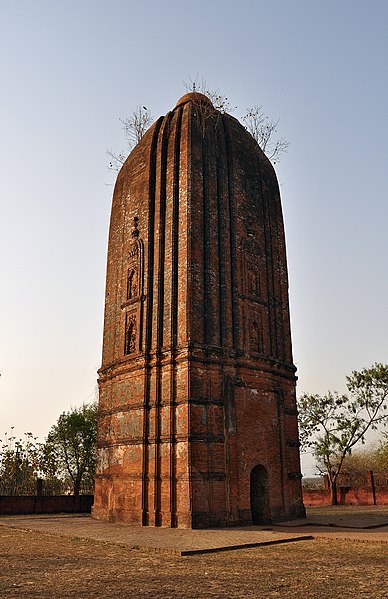Yogini temple of Hirapur
A peculiar form of Yogini.ORISSA-KALINGA OR Utkala of ancient times-is an experience that is as sublime as it is aesthetically innervating. In its very isolation, Orissa has preserved some of the most important aspects of India's own cultural heritage. It is for this reason that the State has so much to offer the curious traveller who seeks to unfold new mysteries.
The temple culture is the most predominant feature that strikes the visitor who enters Orissa. There are temples not much celebrated for their ornamental sculpture and structural beauty but are known for their dynamically forceful religious architecture and powerful nuances. One of them is the 64 yoginis' temple at Hirapur. On the suburbs of Orissa, 20 km south-east of the city, in the middle of paddy fields lies this ninth century temple. Another significant feature of this shrine is that it is hypaethral (no roof). It assumes an important place in the cultural history since it is the second of its kind in Orissa and one of such four temples in India. (Two of them are in Orissa and the other two are in Madhya Pradesh). It belongs to a genre of architecture which is completely different from the major Odissi school. Yogini shrines can be seen at Hirapur (near Bhubaneswar) and at Ranipur-Jharial (western Orissa).
The early medieval period saw the development of the cult of yoginis which was of course, based on the Sakta principle. Though this cult has cryptic origin, it has a long history of its own with distribution all over India except the South. Experts and scholars from different walks of life propounded many theories in support of their origin and expansion but failed to come to a definite conclusion. The reason may be the non-availability of authentic texts and cessation of occult practices.

Yogini, 64 in number, in their niches on a circular wall.Vedic texts also speak about some individual yoginis but never register the coalescence of 64 yoginis together as a cult. The yogini cult is said to have developed in the 6th/7th A.D. The temple at Hirapur was discovered by the late K. N. Mahapatra, eminent historian and archaeologist of Orissa. The temple has 64 niches one for each image of the yogini. Now who are these yoginis? In the absence of text books on the subject one has to rely on the puranas. Markandeya Purana gives an interesting account of the origin of the great goddess and Yoginis as Matrkas. They were asked to assist Durga in her war against Raktabija a demon king who would multiply from each drop of his blood shed on the ground. Such was the dreadful boon he had managed to get. The yoginis, directed by Durga, drank all the drops of blood before they could touch the ground and the demon was killed. The Mahabhagavata purana records that Mahadeva delineates the residence of Kali as a vast city with a wall having four gates facing the four directions. Seated in the middle on a lion-throne is the Goddess, attended by 64 yoginis and Bhairavas who are entrusted with the protection of the city.
But most exciting is the account presented in Matsya purana. Andhaka, an asura, was terrorising the whole universe. Once he attacked Kailasa in an attempt to capture Umadevi. Siva countered with his Pasupata Astra. But due to a boon (a la Raktabija) innumberable demons of sprang up from the blood pouring from his wounds. Siva created several divine mothers who drank all the blood and the demon was destroyed. But this led to a new problem. The mothers went on rampage and Siva sought the help of Narasimha, who created 32 mothers, more formidable.
Unable to withstand their power the forms created by Siva went to Narasimha who advised them to nurture and guard the universe. They should assist Parasakthi in her divine work.
Entrance to the temple.The cult of 64 yoginis as well as its occult and secret practices and philosophy are methodised by Matsyendranath (8th to 10th century AD) in his magnum opus, Kaulajnananimaya. He is associated with religious movements of medieval India and is revered in neighbouring countries like Nepal and Tibet. Even in Kashmir he is worshipped as Saiva Acharya.
The number of yoginis differ from one source to another but 64 appears to have been generally accepted. The principal yoginis, also known as Mother-Goddesses, are Brahmani, Mahesvari, Vaishnavi, Kaumari, Varahi, Indrani and Chamunda who according to the myths were created to the drink blood of demons.. It is presumptive that these mother-goddesses who are evidently the Yoginis were multiplied into sixty-four.
A circular wall, hardly 2 metres in height, containing 64 niches within its inner circumference encompass this hypaethral yogini shrine. All except one of these contain an image of a yogini goddess. Some of them are delineated with voluptuous bodies, some with horrific shrunken features, still others with animal heads.
Active between 9th and 13th centuries, yoginis were worshipped in expectation of the direct acquisition of supernatural powers. Worship seems to have centred on the repetition of the names of the goddesses. Later, when active use of the shrines ceased, worshippers transferred their devotions to mystical paper diagrams.
Decorated predominantly in red is Chandi Devi.A circular enclosure open to the sky is also the distinctive shape of the shrines dedicated to the yoginis. V.W. Karambelkar, points out that the circular shape and absence of roof of Yogini temples find a justification in some ancient legends about the yoginis themselves. It is stated that these deities use to roam about in a group in the air and when they descend, always settled in a circle.
The circular yogini temple can be considered to be an iconic representation of Siva and Sakti, the former being placed at the centre in the role as axis mundi , the latter having multiplied into 64 female deities surrounding Siva in a circle as per the mandala-chakra-yantra tradition.
This peculiar kind of temple architecture developed in the central and eastern parts of India between the 8th and 12th centuries AD. This style of architecture finds no mention in silpa-sastras as they were kept secret by the sectarian practitioners of the cult.






































